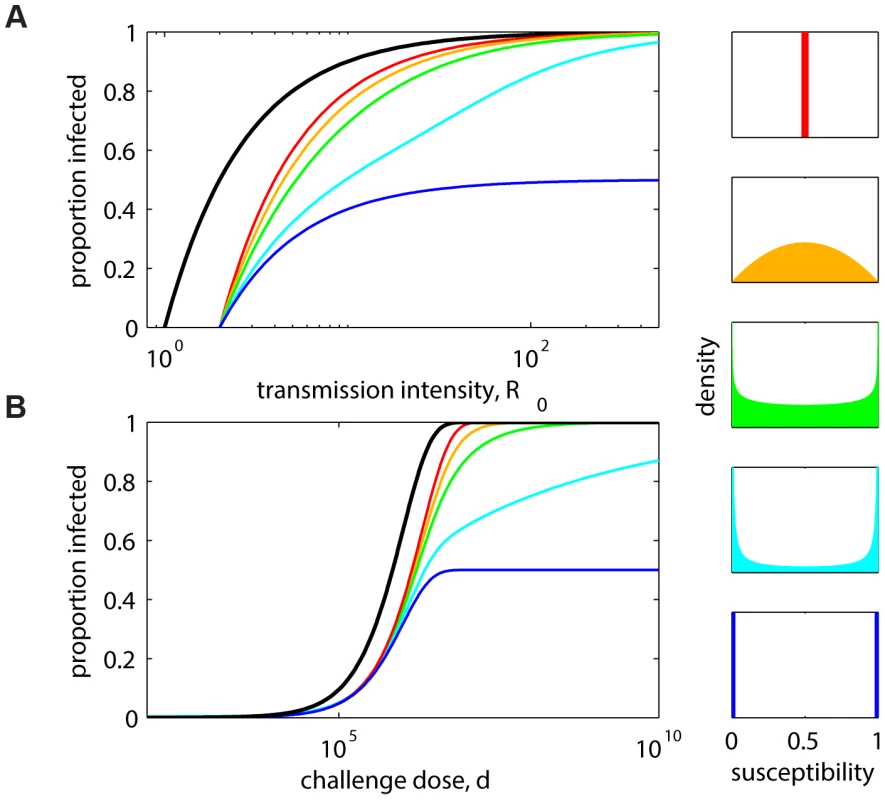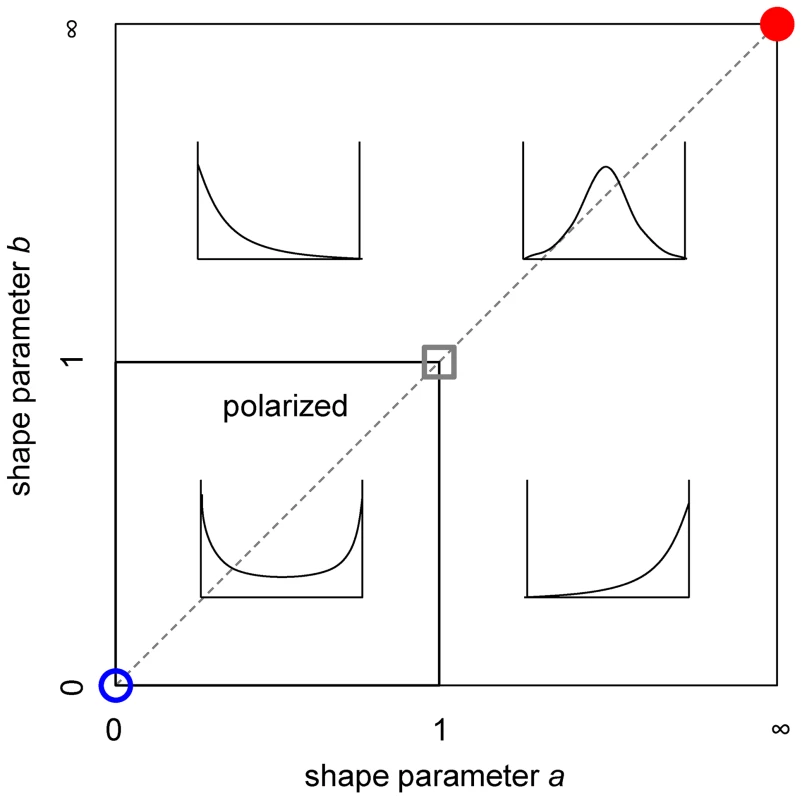A Missing Dimension in Measures of Vaccination Impacts
article has not abstract
Published in the journal:
. PLoS Pathog 10(3): e32767. doi:10.1371/journal.ppat.1003849
Category:
Opinion
doi:
https://doi.org/10.1371/journal.ppat.1003849
Summary
article has not abstract
Immunological protection, acquired from either natural infection or vaccination, varies among hosts, reflecting underlying biological variation and affecting population-level protection. Owing to the nature of resistance mechanisms, distributions of susceptibility and protection entangle with pathogen dose in a way that can be decoupled by adequately representing the dose dimension. Any infectious processes must depend in some fashion on dose, and empirical evidence exists for an effect of exposure dose on the probability of transmission to mumps-vaccinated hosts [1], the case-fatality ratio of measles [2], and the probability of infection and, given infection, of symptoms in cholera [3]. Extreme distributions of vaccine protection have been termed leaky (partially protects all hosts) and all-or-nothing (totally protects a proportion of hosts) [4]. These distributions can be distinguished in vaccine field trials from the time dependence of infections [5]. Frailty mixing models have also been proposed to estimate the distribution of protection from time to event data [6], [7], although the results are not comparable across regions unless there is explicit control for baseline transmission [8]. Distributions of host susceptibility and acquired protection can be estimated from dose-response data generated under controlled experimental conditions [9]–[11] and natural settings [12], [13]. These distributions can guide research on mechanisms of protection, as well as enable model validity across the entire range of transmission intensities. We argue for a shift to a dose-dimension paradigm in infectious disease science and community health.
Natural Transmission
We consider a minimal susceptible (S) and infected (I) model [14] of pathogen transmission in a host population to explore population effects of protection conferred by a vaccine (or other preventive measure, such as symbionts) against infection, under different assumptions about how this is distributed among individuals. We consider that infection is lifelong, and that there is no naturally acquired immunity.
Vaccines that provide leaky protection against infection act by reducing susceptibility to a factor σ that is distributed among individuals according to a probability density function , where . Denoting by the densities of hosts who are vaccinated and have susceptibility factor , the integral represents the proportion of hosts who are infected despite being vaccinated. Assuming no effect on infectiousness, the per capita rate of infection among totally susceptible individuals is given by , where β is the effective contact rate.
Figure 1A shows, for the distributions represented on the right, equilibrium curves describing prevalence of infection versus transmission intensity measured by , the basic reproduction number. The curves for extreme cases of vaccines that confer equal protection to all or total protection to some and none to others are depicted by the higher (red) and lower (blue) curves, respectively. Intermediate curves represent scenarios in which susceptibility follows a beta distribution with fixed mean and increasing variance from top to bottom. Prevalence curves become shallower with heterogeneity and converge to the same level as transmission increases, except in the all-or-nothing extreme, in which the prevalence cannot surpass the susceptible fraction, irrespective of transmission intensity. Although the impact of protection appears to increase with polarization of effects, the endemic curves do not converge uniformly to their all-or-nothing homologue. In the absence of unequivocal empirical evidence for the idealized all-or-nothing mode of action, we suggest modifying the terminology to include polarized distributions more generally.

This illustration indicates that the distribution of vaccine effects among individuals is a major determinant of population-level impact and should be considered in evaluation. Specifically, the more homogeneously a vaccine acts, the lower its impact on disease transmission. Measures based on multipopulation study designs, spanning a range of transmission intensities, enable the inference of such distributions.
Experimental Challenge
Infection in a controlled experimental setting is modeled by describing infected proportions in terms of challenge dose. Adopting standard formulations [15]–[17], the mean number of infecting pathogens is, where d is the number of pathogens challenging the host, and p is the probability of infection for each pathogen; the number of infecting pathogens per host has a Poisson distribution with mean . In the homogeneous case, the probability of a host remaining uninfected after pathogen challenge is the zero term of the distribution, leading to a probability of infection, represented by the black curve in Figure 1B.
This model fails to fit many experimental data sets in which groups of hosts are exposed to varying doses of the pathogen, and the proportion infected in each group is calculated. In particular, the slope of the curve implied by this model is steeper than what is often observed. However, if individual hosts vary in their susceptibility to infection, a reduced slope arises. A simple model [11] assumes that the probability of each particle causing infection varies among hosts according to a beta distribution , akin to the vaccine protection factor above, resulting in the modified dose-response .
Figure 1B illustrates dose-infectivity curves expected from an experiment in which groups of naive and vaccinated hosts are challenged with a range of pathogen doses under the distributions of protection described above, uncovering again a lack of uniform convergence to the all-or-nothing formulation.
We have adopted the same notation, , for susceptibility distributions in both natural transmission and experimental challenge settings to indicate the linkage between two arms of a unified study, as advocated here.
Classification of Intervention Effects
Experimental dose-infectivity curves provide information to infer the mode of action of interventions, such as vaccines. Given the lack of uniform convergence to all-or-nothing as the leaky mode becomes increasingly polarized, we have classified beta distribution shapes according to polarization (Figure 2). The dashed line along the diagonal indicates the location of the symmetric distributions used in Figure 1, and the circles indicate the location of the extreme homogeneous (red) and all-or-nothing (blue) distributions. The power to identify polarized distributions is analyzed in Figure S1, focusing on a vicinity of the uniform shape (gray square), showing good discriminatory power in the region of parameter space where uncertainty is greatest. This analysis suggests a promising approach for classifying intervention effects in controlled experimental settings and using this as prior information for further study in natural settings [18].

Supporting Information
Zdroje
1. BarskeyAE, Cynthia SchulteC, RosenJB, HandschurEF, Rausch-PhungE, et al. (2012) Mumps Outbreak in Orthodox Jewish Communities in the United States. N Engl J Med 367: 1704–1713.
2. AabyP, BukhJ, LisseIM, SmithsAJ (1984) Overcrowding and intensive exposure as determinants of measles mortality. Am J Epidemiol 120: 49–63.
3. HornickRB, MusicSI, WenzelR, CashR, LibonatiJP, et al. (1971) The Broad Street pump revisited: Response of volunteers to ingested cholera vibrios. Bull N Y Acad Med 47: 1181–1191.
4. Halloran ME, Longini IM Jr, Struchiner CJ (2010) Design and Analysis of Vaccine Studies. New York: Springer.
5. SmithPG, RodriguesLC, FinePE (1984) Assessment of the protective efficacy of vaccines against common diseases using case-control and cohort studies. Int J Epidemiol 13: 87–93.
6. HalloranME, LonginiIMJr, StruchinerCJ (1996) Estimability and interpretability of vaccine efficacy using frailty mixing models. Am J Epidemiol 144: 83–97.
7. LonginiIMJr, HalloranME (1996) A frailty mixture model for estimating vaccine efficacy. Appl Statist 45: 165–173.
8. StruchinerCJ, HalloranME (2007) Randomization and baseline transmission in vaccine field trials. Epidemiol Infect 135: 181–194.
9. FurumotoWA, MickeyR (1967) A mathematical model for the infectivity-dilution curve of tobacco mosaic virus: Theoretical consideration. Virology 32: 216–223.
10. FurumotoWA, MickeyR (1967) A mathematical model for the infectivity-dilution curve of tobacco mosaic virus: Experimental tests. Virology 32: 224–233.
11. Haas CN, Rose JB, Gerba CP (1999) Quantitative Microbial Risk Assessment. New York: John Wiley & Sons, Inc.
12. SmithDL, DushoffJ, SnowRW, HaySI (2005) The entomological inoculation rate and Plasmodium falciparum infection in African children. Nature 438: 492–495.
13. GomesMGM, AguasR, LopesJS, NunesMC, RebeloC, et al. (2012) How host selection governs tuberculosis reinfection. Proc R Soc B 279: 2473–2478.
14. Keeling MJ, Rohani P (2008) Modeling Infectious Diseases in Humans and Animals. New Jersey: Princeton University Press.
15. DruettHA (1952) Bacterial invasion. Nature 170: 288.
16. Ben-AmiF, RegoesRR, EbertD (2008) A quantitative test of the relationship between parasite dose and infection probability across different host-parasite combinations. Proc R Soc B 275: 853–859.
17. ZwartMP, HemerikL, CoryJS, de VisserJAGM, BianchiFJJA, et al. (2011) An experimental text of the independent action hypothesis in virus-insect pathosystems. Proc R Soc B 276: 2233–2242.
18. DwyerG, ElkintonJS, BuonaccorsiJP (1997) Host heterogeneity in susceptibility and disease dynamics: Tests of a mathematical model. Am Nat 150: 685–707.
Štítky
Hygiena a epidemiologie Infekční lékařství LaboratořČlánek vyšel v časopise
PLOS Pathogens
2014 Číslo 3
- Měli bychom postcovidový syndrom léčit antidepresivy?
- Jak souvisí postcovidový syndrom s poškozením mozku?
- Farmakovigilanční studie perorálních antivirotik indikovaných v léčbě COVID-19
- 10 bodů k očkování proti COVID-19: stanovisko České společnosti alergologie a klinické imunologie ČLS JEP
Nejčtenější v tomto čísle
- Cytomegalovirus m154 Hinders CD48 Cell-Surface Expression and Promotes Viral Escape from Host Natural Killer Cell Control
- Human African Trypanosomiasis and Immunological Memory: Effect on Phenotypic Lymphocyte Profiles and Humoral Immunity
- DHX36 Enhances RIG-I Signaling by Facilitating PKR-Mediated Antiviral Stress Granule Formation
- Conflicting Interests in the Pathogen–Host Tug of War: Fungal Micronutrient Scavenging Versus Mammalian Nutritional Immunity
